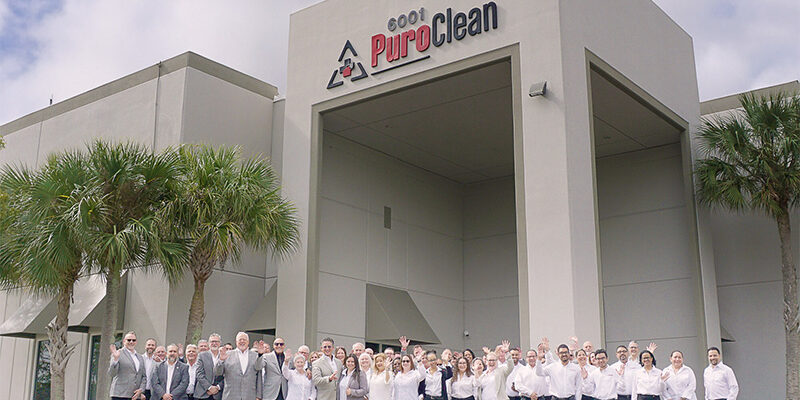Four Timeless Principles for Restoration Project Managers

By Jon Isaacson
I recently had a fun conversation with Randy R. Rapp, the professor of Disaster Restoration and Reconstruction at Purdue University as well as the Associate Professor of Construction Management Technology. As our conversation—which will later be released in episodes of The DYOJO Podcast —ended, I asked the Professor if he had any closing thoughts for professionals developing their project management responsibilities.
Utilizing his experiences in the military, construction management, and disaster restoration response, Professor Rapp shared four principles that he was introduced to in 1984. According to the NY Times, this Airland 2000 battle doctrine marked a fundamental shift in the tactical approach of the armed forces from defensive to offensive. He recalls those foundational disciplines as:
-
Initiative
Agility
-
Depth
-
Synchronization
These timeless principles remain fundamental tenets of battlefield operations for the United States Army. They also serve as core principles that every successful restoration project manager should follow on and off the job. To start, let’s let the Army add some definitions to the terms. We’ll also discuss a fifth principle that was not mentioned in our discussion prior but is helpful for the modern intentional restorer nonetheless.
In doing this, we will be able to showcase how a strong strategy and set of core principles is key to succeeding not just in the armed forces but in leading a restoration team to victory likewise.
Restoration Principle #1: Initiative
‘Initiative’ is one of the most valuable principles any project manager can attain. The Army states, “Leaders anticipate events on the battlefield so that they and their units can act and react faster than the enemy.” Being able to predict and serve as a proactive leader for your team is vital in order to accomplish any job no matter what obstacles may come along with them.
As a manager, project manager, or business owner, if you want your team to succeed, YOU need to set them up for success. Purpose, value, and guiding principles are the ways in which you retain your team and impress your clients alike. Take the initiative to always be prepared. One of your essential roles is to anticipate what could go wrong on a project and prepare your team so as to always be one step ahead.
A great example of this is being sure to look over the entire project before facilitating a deal with your potential client. In war, this can be defined as ‘securing the perimeter.’ It’s a way for you to ensure your team is entering a safe and guaranteed project that won’t lead to stepbacks and problems in the future. With the right initiative, you can not only be ahead of your competitors but keep your team and clients happy without fail.
Restoration Principle #2: Agility
Secondly, agility is crucial for success in restoration project management for multiple reasons. As the Army states, “Ability of friendly forces to react faster than the enemy is a prerequisite for seizing and holding the initiative.”
We marvel at the physical agility of modern athletes. While physical health is important in the realm of construction, it is often the mental agility—and specifically, those soft skills such as building collaboration—which is under-developed among people in a position of leadership. This is where a bit of forethought, intuition, and drive can make all the difference.
As a leader, you have the opportunity to rush onto the ‘battlefield’ at any time and with any strategy you see fit. This is a blessing and a curse depending on how you handle it. A great project manager will recognize this and ensure that they communicate expertly with the client, work diligently with their team, and only make moves that make sense even when it may take a bit more time and effort to do so.
Keeping all eyes on the prize to get the work done on time, on budget, and to the customers’ satisfaction requires everyone to work together. Project managers need to constantly develop their skills to build buy-in and maintain collaborative environments. This can mean anything from transitioning a project as a client sees fit or adding new team members for specific aspects of your restoration process all the way to investing in exciting new equipment and teaching your team how to use it on the job. After all, they don’t say ‘teamwork makes the dream work’ for nothing.
Restoration Principle #3: Depth
Depth is yet another foundational element of successful project management that should always be considered when starting a new job. As the Army describes it, Depth is, “The extension of operations in time, space, resources, and purpose.”
In our conversations and in his own book referenced at the end of this article, Rapp discusses how depth in a construction setting can be defined as both enriching your understanding of the built environment as well as your leadership skills. As he states, “Project managers should always be learning.”
Both Rapp’s project management book and my own dedicate space to the technical as well as the people skills necessary to be successful in a role of leadership. Technical skills are essential for credibility and getting the job done the right way. Meanwhile, people skills are equally important as they encompass customer service interactions and team building to accomplish your shared goals. A good leader will be able to balance these skills and have a deep understanding of how to utilize them to achieve any outcome they desire.
Restoration Principle #4: Synchronization
Lastly, the final military tenet that crosses over to restoration project management is synchronization. The Army describes this strategy as, “Achieving success through coordinated efforts, by arranging activities in time and space to mass at the decisive point.”
Meanwhile, we like to say ‘Connect, Collaborate, and Conquer’ as a means of achieving your goals. Sharing your vision with your team members is essential for empowering them to help you achieve your goals. As stated numerous times by industry contributors adding to my personal project management book, communication is key. Communicating with your customer, the adjuster, and your production teams are critical elements of project success.
With the right communication, collaboration, and roadmap to complete the tasks at hand, you and your team will succeed in every project that lies ahead of you. You will also be recognized and respected for your use of foundational strategies that make you a true leader and better restoration project manager as well.
A Final Project Management Tenet: Versatility
Although the four principles above are the focus of this piece, there is still one more principle to consider for project management success in restoration. In later years, it appears this factor was added to the list by the military making it just as vital for strategy in government affairs as it is for leadership and management.
The Army describes this final tenet as the “Ability to meet diverse mission requirements.” Project Management 101 is the ability to start the day with a plan of action while always being prepared to be interrupted.
In water damage scenarios, this may be an emergency call for service. For repairs during the pandemic, this may be supply chain issues. Running a successful business—or being a good practitioner—is not about what you do when everything is going well, but rather how well prepared you are for when things go awry.
Therefore, be ready for any and all setbacks and go with the flow as best as you can. This is the key to turning a major setback into a minor inconvenience and saving time, money, and your reputation along the way.
Developing Your Project Management Skills
When beginning to implement these strategies, it is best to continue to learn and listen to others in the industry that have proven to be influential and successful. This is why Randy Rapp’s insights are so valuable to seasoned and green project managers all the same.
No matter how long you’ve been a project manager, you are sure to find that Randy’s book is a literal manuscript for improving your processes and procedures. While he teaches at the college level, he is masterful in bringing key principles to the ground level where aspiring professionals can absorb the information and apply it to their daily practice.
For those of you who are looking to improve your project management acumen, Rapp’s book, Disaster Recovery Project Management: Bringing Order from Chaos, should be required reading for you and your team. Similarly, for those of you who are aspiring to grow your career, I wrote So, You Want To Be A Project Manager? to help you understand the mindset and habits that will lead to professional development. Hopefully, with the principles outlined above along with these essential reads under your belt, you can start to see the success and rapid results you’ve been looking for in your projects without all the uncertainty and stress that so commonly goes along with them.
To learn more about restoration project management, check out these Property Restoration and Cleaning Service-Based Podcasts compiled by Jon Isaacson as well.
NOTE: Randy and Pete Consigli were kind enough to allow me to adapt the Preface from Pete’s white paper Insurance Restoration Terminology and Damage Repair Sequence as the foreword to So, You Want To Be A Project Manager?
Jon Isaacson, known as the “Intentional Restorer,” is a contractor, an author, and the host of the DYOJO Podcast. Jon speaks, writes, and coaches start-up phase owners and growth-minded restoration professionals through his organization, The DYOJO. Isaacson is the author of the Be Intentional book series for restorers. Reach him at [email protected].

















